PUBH6001 Assignment 2: Health Policy Analysis - WA Women's Health
VerifiedAdded on 2022/09/16
|10
|2579
|73
Essay
AI Summary
This assignment provides a comprehensive analysis of the Western Australian Women's Health and Wellbeing Policy. It begins with an introduction to health policy and its objectives, specifically focusing on the context of women's health in Western Australia. The essay explores the problems addressed by the policy, including sexual and reproductive health issues, and examines the Department of Health in Western Australia as the dominant frame of reference. It identifies the target stakeholders, including women and various representative groups, and details the policy process, highlighting the involvement of different stakeholders. The analysis then delves into the policy solutions, which include promoting healthy behaviors, focusing on risk factors, early detection, and holistic care. The essay also evaluates the policy's effectiveness, considering its dissemination, accountability processes, and evaluation indicators. The analysis concludes with a summary of the policy's impact on the wellbeing of women and the broader economic status of the region.

Running head: HEALTH POLICY ANALYSIS 1
Health Policy and advocacy
Introduction
Health policy refers to actions, decisions, and plans that are undertaken by a state to
reach certain healthcare objectives. A clear health policy achieves several things, which
include determination of future vision that helps in establishing certain targets and reference
points both short and medium-term. In Australia, there are different health policy problems,
including preventive health policy, mental health policy, women's health policy, Torres Strait
Island, and Aboriginal health policy and men's health policy. The problems need to be
addressed in different perspectives to make sure satisfaction in Australia. The health policy to
be addressed in the paper is Western Australian Women’s Health and Wellbeing Policy. The
paper greatly deals with the analysis of the preventative health policy.
Problem and Context
The Western Australian woman's health policy emerged with the objective of
improving women's health care. At the federal level, the Women’s health policy tried to make
significant gains for all the women in the society despite certain setbacks in the sector of
reproductive rights. The policy became a strong political force, and most of the sectors gave
significant support (Government of Western Australia, 2019). Historically, women regarded
as consumer health activists wanted changes in the health care sector. The woman’s rights
campaigners demanded equal rights for all the women in the state. The women's activities
working in different arenas came together purposely for the election of supportive
governments, employment of feminists in different key positions, and come up with
opportunities for expansion of the policy afforded by federalism. The influences within the
Australian context of support for social liberalism account for the policy position of the
country.
Health Policy and advocacy
Introduction
Health policy refers to actions, decisions, and plans that are undertaken by a state to
reach certain healthcare objectives. A clear health policy achieves several things, which
include determination of future vision that helps in establishing certain targets and reference
points both short and medium-term. In Australia, there are different health policy problems,
including preventive health policy, mental health policy, women's health policy, Torres Strait
Island, and Aboriginal health policy and men's health policy. The problems need to be
addressed in different perspectives to make sure satisfaction in Australia. The health policy to
be addressed in the paper is Western Australian Women’s Health and Wellbeing Policy. The
paper greatly deals with the analysis of the preventative health policy.
Problem and Context
The Western Australian woman's health policy emerged with the objective of
improving women's health care. At the federal level, the Women’s health policy tried to make
significant gains for all the women in the society despite certain setbacks in the sector of
reproductive rights. The policy became a strong political force, and most of the sectors gave
significant support (Government of Western Australia, 2019). Historically, women regarded
as consumer health activists wanted changes in the health care sector. The woman’s rights
campaigners demanded equal rights for all the women in the state. The women's activities
working in different arenas came together purposely for the election of supportive
governments, employment of feminists in different key positions, and come up with
opportunities for expansion of the policy afforded by federalism. The influences within the
Australian context of support for social liberalism account for the policy position of the
country.
Paraphrase This Document
Need a fresh take? Get an instant paraphrase of this document with our AI Paraphraser
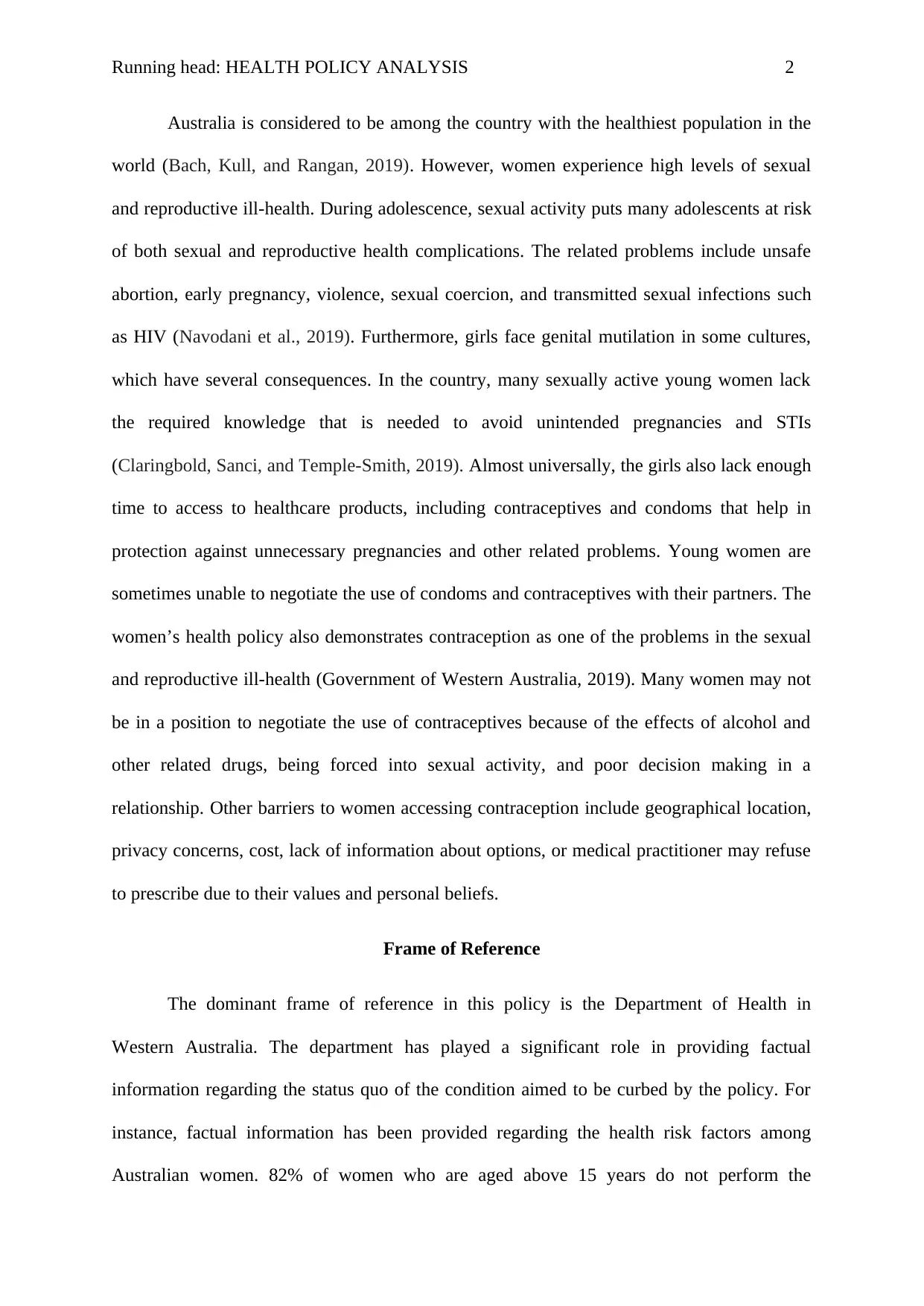
Running head: HEALTH POLICY ANALYSIS 2
Australia is considered to be among the country with the healthiest population in the
world (Bach, Kull, and Rangan, 2019). However, women experience high levels of sexual
and reproductive ill-health. During adolescence, sexual activity puts many adolescents at risk
of both sexual and reproductive health complications. The related problems include unsafe
abortion, early pregnancy, violence, sexual coercion, and transmitted sexual infections such
as HIV (Navodani et al., 2019). Furthermore, girls face genital mutilation in some cultures,
which have several consequences. In the country, many sexually active young women lack
the required knowledge that is needed to avoid unintended pregnancies and STIs
(Claringbold, Sanci, and Temple-Smith, 2019). Almost universally, the girls also lack enough
time to access to healthcare products, including contraceptives and condoms that help in
protection against unnecessary pregnancies and other related problems. Young women are
sometimes unable to negotiate the use of condoms and contraceptives with their partners. The
women’s health policy also demonstrates contraception as one of the problems in the sexual
and reproductive ill-health (Government of Western Australia, 2019). Many women may not
be in a position to negotiate the use of contraceptives because of the effects of alcohol and
other related drugs, being forced into sexual activity, and poor decision making in a
relationship. Other barriers to women accessing contraception include geographical location,
privacy concerns, cost, lack of information about options, or medical practitioner may refuse
to prescribe due to their values and personal beliefs.
Frame of Reference
The dominant frame of reference in this policy is the Department of Health in
Western Australia. The department has played a significant role in providing factual
information regarding the status quo of the condition aimed to be curbed by the policy. For
instance, factual information has been provided regarding the health risk factors among
Australian women. 82% of women who are aged above 15 years do not perform the
Australia is considered to be among the country with the healthiest population in the
world (Bach, Kull, and Rangan, 2019). However, women experience high levels of sexual
and reproductive ill-health. During adolescence, sexual activity puts many adolescents at risk
of both sexual and reproductive health complications. The related problems include unsafe
abortion, early pregnancy, violence, sexual coercion, and transmitted sexual infections such
as HIV (Navodani et al., 2019). Furthermore, girls face genital mutilation in some cultures,
which have several consequences. In the country, many sexually active young women lack
the required knowledge that is needed to avoid unintended pregnancies and STIs
(Claringbold, Sanci, and Temple-Smith, 2019). Almost universally, the girls also lack enough
time to access to healthcare products, including contraceptives and condoms that help in
protection against unnecessary pregnancies and other related problems. Young women are
sometimes unable to negotiate the use of condoms and contraceptives with their partners. The
women’s health policy also demonstrates contraception as one of the problems in the sexual
and reproductive ill-health (Government of Western Australia, 2019). Many women may not
be in a position to negotiate the use of contraceptives because of the effects of alcohol and
other related drugs, being forced into sexual activity, and poor decision making in a
relationship. Other barriers to women accessing contraception include geographical location,
privacy concerns, cost, lack of information about options, or medical practitioner may refuse
to prescribe due to their values and personal beliefs.
Frame of Reference
The dominant frame of reference in this policy is the Department of Health in
Western Australia. The department has played a significant role in providing factual
information regarding the status quo of the condition aimed to be curbed by the policy. For
instance, factual information has been provided regarding the health risk factors among
Australian women. 82% of women who are aged above 15 years do not perform the
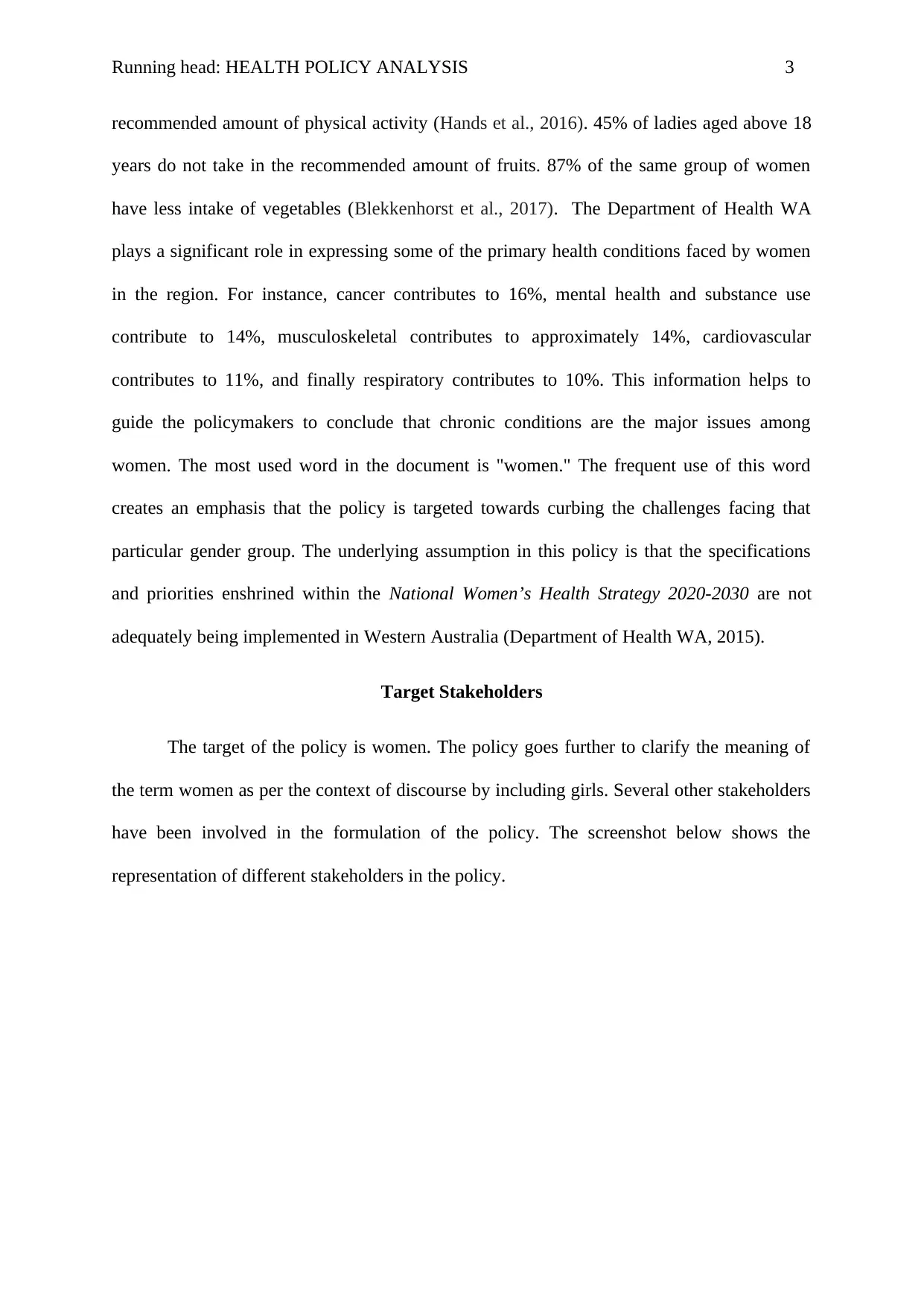
Running head: HEALTH POLICY ANALYSIS 3
recommended amount of physical activity (Hands et al., 2016). 45% of ladies aged above 18
years do not take in the recommended amount of fruits. 87% of the same group of women
have less intake of vegetables (Blekkenhorst et al., 2017). The Department of Health WA
plays a significant role in expressing some of the primary health conditions faced by women
in the region. For instance, cancer contributes to 16%, mental health and substance use
contribute to 14%, musculoskeletal contributes to approximately 14%, cardiovascular
contributes to 11%, and finally respiratory contributes to 10%. This information helps to
guide the policymakers to conclude that chronic conditions are the major issues among
women. The most used word in the document is "women." The frequent use of this word
creates an emphasis that the policy is targeted towards curbing the challenges facing that
particular gender group. The underlying assumption in this policy is that the specifications
and priorities enshrined within the National Women’s Health Strategy 2020-2030 are not
adequately being implemented in Western Australia (Department of Health WA, 2015).
Target Stakeholders
The target of the policy is women. The policy goes further to clarify the meaning of
the term women as per the context of discourse by including girls. Several other stakeholders
have been involved in the formulation of the policy. The screenshot below shows the
representation of different stakeholders in the policy.
recommended amount of physical activity (Hands et al., 2016). 45% of ladies aged above 18
years do not take in the recommended amount of fruits. 87% of the same group of women
have less intake of vegetables (Blekkenhorst et al., 2017). The Department of Health WA
plays a significant role in expressing some of the primary health conditions faced by women
in the region. For instance, cancer contributes to 16%, mental health and substance use
contribute to 14%, musculoskeletal contributes to approximately 14%, cardiovascular
contributes to 11%, and finally respiratory contributes to 10%. This information helps to
guide the policymakers to conclude that chronic conditions are the major issues among
women. The most used word in the document is "women." The frequent use of this word
creates an emphasis that the policy is targeted towards curbing the challenges facing that
particular gender group. The underlying assumption in this policy is that the specifications
and priorities enshrined within the National Women’s Health Strategy 2020-2030 are not
adequately being implemented in Western Australia (Department of Health WA, 2015).
Target Stakeholders
The target of the policy is women. The policy goes further to clarify the meaning of
the term women as per the context of discourse by including girls. Several other stakeholders
have been involved in the formulation of the policy. The screenshot below shows the
representation of different stakeholders in the policy.
⊘ This is a preview!⊘
Do you want full access?
Subscribe today to unlock all pages.

Trusted by 1+ million students worldwide
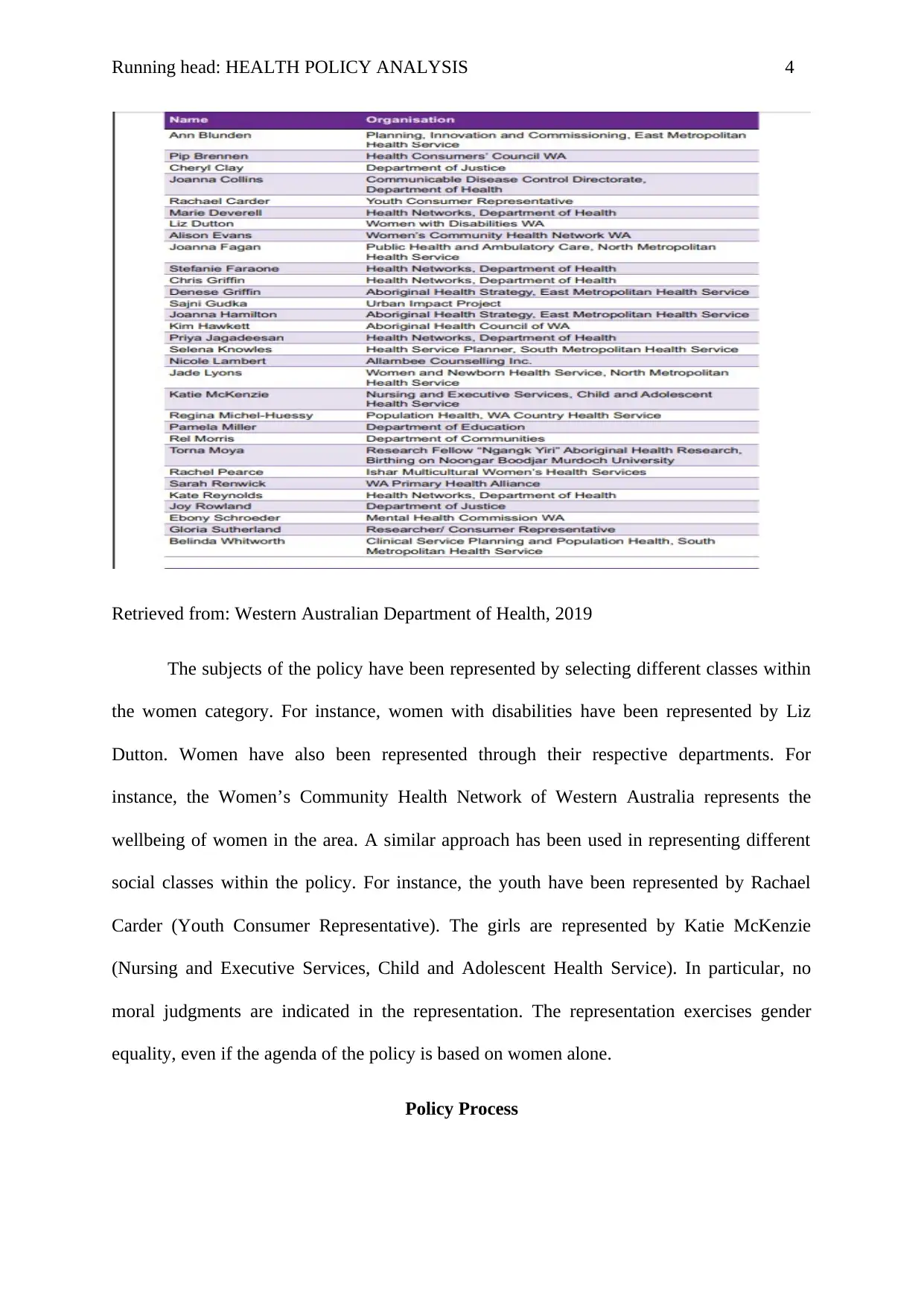
Running head: HEALTH POLICY ANALYSIS 4
Retrieved from: Western Australian Department of Health, 2019
The subjects of the policy have been represented by selecting different classes within
the women category. For instance, women with disabilities have been represented by Liz
Dutton. Women have also been represented through their respective departments. For
instance, the Women’s Community Health Network of Western Australia represents the
wellbeing of women in the area. A similar approach has been used in representing different
social classes within the policy. For instance, the youth have been represented by Rachael
Carder (Youth Consumer Representative). The girls are represented by Katie McKenzie
(Nursing and Executive Services, Child and Adolescent Health Service). In particular, no
moral judgments are indicated in the representation. The representation exercises gender
equality, even if the agenda of the policy is based on women alone.
Policy Process
Retrieved from: Western Australian Department of Health, 2019
The subjects of the policy have been represented by selecting different classes within
the women category. For instance, women with disabilities have been represented by Liz
Dutton. Women have also been represented through their respective departments. For
instance, the Women’s Community Health Network of Western Australia represents the
wellbeing of women in the area. A similar approach has been used in representing different
social classes within the policy. For instance, the youth have been represented by Rachael
Carder (Youth Consumer Representative). The girls are represented by Katie McKenzie
(Nursing and Executive Services, Child and Adolescent Health Service). In particular, no
moral judgments are indicated in the representation. The representation exercises gender
equality, even if the agenda of the policy is based on women alone.
Policy Process
Paraphrase This Document
Need a fresh take? Get an instant paraphrase of this document with our AI Paraphraser
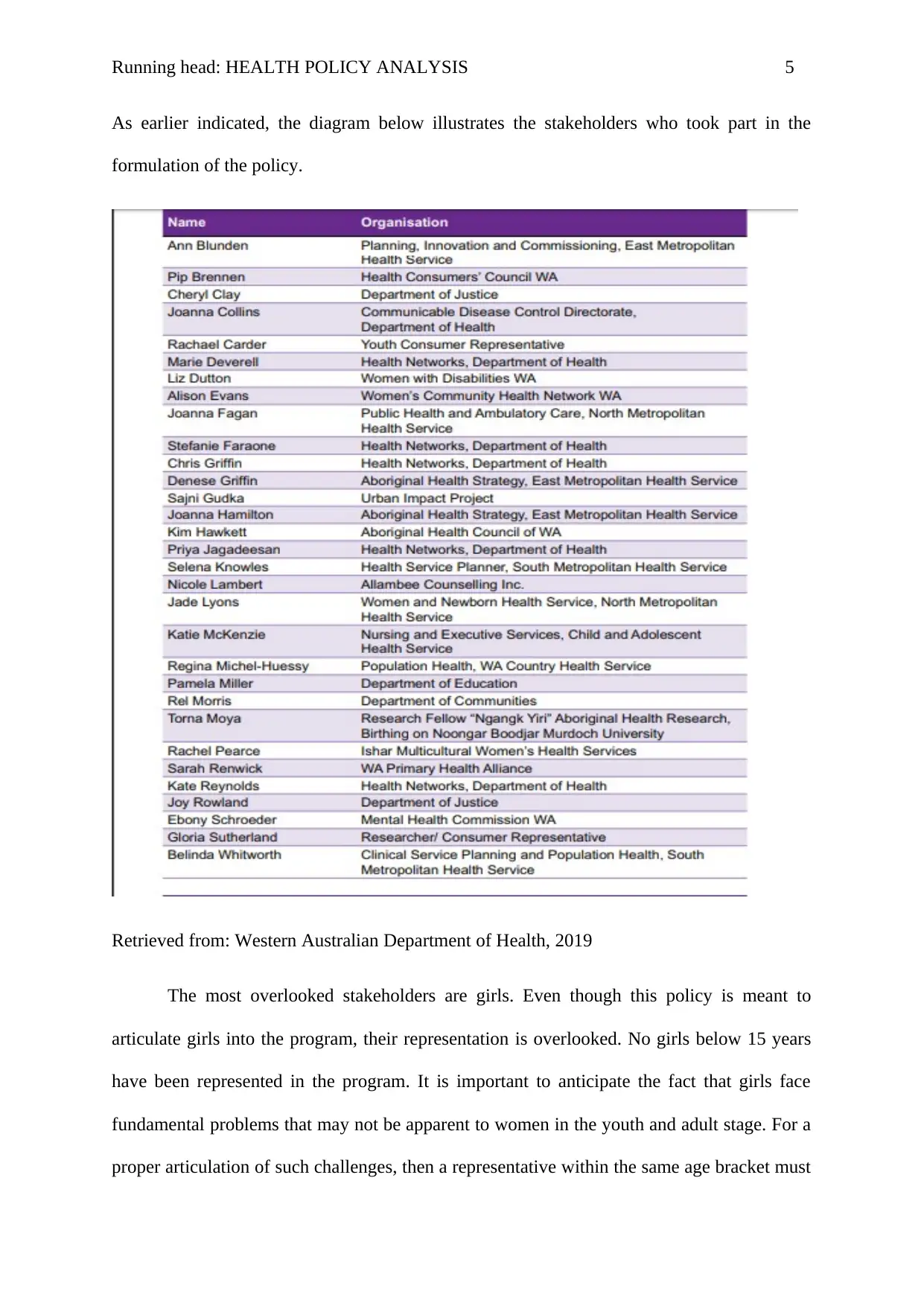
Running head: HEALTH POLICY ANALYSIS 5
As earlier indicated, the diagram below illustrates the stakeholders who took part in the
formulation of the policy.
Retrieved from: Western Australian Department of Health, 2019
The most overlooked stakeholders are girls. Even though this policy is meant to
articulate girls into the program, their representation is overlooked. No girls below 15 years
have been represented in the program. It is important to anticipate the fact that girls face
fundamental problems that may not be apparent to women in the youth and adult stage. For a
proper articulation of such challenges, then a representative within the same age bracket must
As earlier indicated, the diagram below illustrates the stakeholders who took part in the
formulation of the policy.
Retrieved from: Western Australian Department of Health, 2019
The most overlooked stakeholders are girls. Even though this policy is meant to
articulate girls into the program, their representation is overlooked. No girls below 15 years
have been represented in the program. It is important to anticipate the fact that girls face
fundamental problems that may not be apparent to women in the youth and adult stage. For a
proper articulation of such challenges, then a representative within the same age bracket must

Running head: HEALTH POLICY ANALYSIS 6
be present. Furthermore, it is apparent that most of the issues being handled in the policy are
directed towards the adult and youth women and neglect the girl child irrespective of the
inclusion of “girl” in the “woman” definition. Therefore, even though the interests of women
(adults, youth, and children) were represented in the development of the policy, the children
and youth were overlooked. The representative for women with disabilities may have
contrasting interests comparative to the youth consumer representative. On the same note, the
interests may conflict when it comes to the representative for the children. On the other hand,
the Department of Justice must ensure that no substantial differences are created between
these groups. On the same note, the Department for Justice must ensure there are no
sentiments that violate the rights of men either. In such a case, there is potential for
contrasting interests among the stakeholders involved in the formulation of the policy. The
motivation of the stakeholders in making this policy is the failure of the National Women’s
Health Strategy 2020-2030 to curb the intended challenges circumnavigating the wellbeing of
women in Western Australia. The greatest opportunity that guided in the development of the
policy is the incentive among all organizations (both governmental and non-governmental) to
support the program. These organizations include Women and Newborn Health Network,
women’s community health sector, and communities in general. Therefore, the development
of the policy was well supported by professionalism in all sectors of health and wellbeing.
Policy Solutions
There are four primary policy solutions to the problems revolving around women's
wellbeing in Western Australia. Firstly, the policy recommends the promotion of healthy
behaviors and healthy agingaging in all women for the prevention of the development of
predisposing factors to chronic conditions. Secondly, the policy purports a focus on the
associated risk factors as a strategic approach in curbing chronic conditions. Furthermore, the
policy advocates early detection and intervention to chronic conditions. Lastly, the policy is
be present. Furthermore, it is apparent that most of the issues being handled in the policy are
directed towards the adult and youth women and neglect the girl child irrespective of the
inclusion of “girl” in the “woman” definition. Therefore, even though the interests of women
(adults, youth, and children) were represented in the development of the policy, the children
and youth were overlooked. The representative for women with disabilities may have
contrasting interests comparative to the youth consumer representative. On the same note, the
interests may conflict when it comes to the representative for the children. On the other hand,
the Department of Justice must ensure that no substantial differences are created between
these groups. On the same note, the Department for Justice must ensure there are no
sentiments that violate the rights of men either. In such a case, there is potential for
contrasting interests among the stakeholders involved in the formulation of the policy. The
motivation of the stakeholders in making this policy is the failure of the National Women’s
Health Strategy 2020-2030 to curb the intended challenges circumnavigating the wellbeing of
women in Western Australia. The greatest opportunity that guided in the development of the
policy is the incentive among all organizations (both governmental and non-governmental) to
support the program. These organizations include Women and Newborn Health Network,
women’s community health sector, and communities in general. Therefore, the development
of the policy was well supported by professionalism in all sectors of health and wellbeing.
Policy Solutions
There are four primary policy solutions to the problems revolving around women's
wellbeing in Western Australia. Firstly, the policy recommends the promotion of healthy
behaviors and healthy agingaging in all women for the prevention of the development of
predisposing factors to chronic conditions. Secondly, the policy purports a focus on the
associated risk factors as a strategic approach in curbing chronic conditions. Furthermore, the
policy advocates early detection and intervention to chronic conditions. Lastly, the policy is
⊘ This is a preview!⊘
Do you want full access?
Subscribe today to unlock all pages.

Trusted by 1+ million students worldwide

Running head: HEALTH POLICY ANALYSIS 7
directed towards the provision of holistic care and management to support women. There are
no alternative solutions to the actions stipulated in this policy because the policy is explosive
enough on its specific courses of action based on respective priority areas. The
recommendations stipulated in this policy have fundamental social/power/ethical
implications. For instance, most of the preventive mechanisms advocated will reduce the
expenditures on the healthcare sector, thus promoting economic wellbeing. On the same note,
it is imperative to acknowledge the fact that healthy living a starting point is promoting social
wellbeing in an economy (Abma et al., 2019; Chervonsky and Hunt, 2019; Gubhaju et al.,
2019). The integrated approach emphasized in the policy also promotes social wellbeing in an
economy.
Effectiveness
The implementation of the policy is effective. In the first place, the dissemination of
the policy has been placed on the Department of Health, which is an effective body in
reaching all the healthcare systems in Western Australia and relevant external bodies. On the
same note, the use of the official website of the Department of Health creates a sense of
legality to the public. Most importantly, the use of social media platforms has rapidly
increased among the Aboriginals in Western Australia (Rice et al., 2016). The accountability
processes of the policy have been expressed under the role of the Department of Health,
which will measure the level of awareness of the policy for evaluation purposes. Evaluation
indicators for the policy include the prevalence of chronic conditions among women, trends
in gender-based violence, level of maternal, reproductive and sexual health, and mental
health and wellbeing. In this case, it is impossible to measure the effectiveness of the policy
following its short time after implementation. However, the awareness of the policy among
the public renders the program effective.
directed towards the provision of holistic care and management to support women. There are
no alternative solutions to the actions stipulated in this policy because the policy is explosive
enough on its specific courses of action based on respective priority areas. The
recommendations stipulated in this policy have fundamental social/power/ethical
implications. For instance, most of the preventive mechanisms advocated will reduce the
expenditures on the healthcare sector, thus promoting economic wellbeing. On the same note,
it is imperative to acknowledge the fact that healthy living a starting point is promoting social
wellbeing in an economy (Abma et al., 2019; Chervonsky and Hunt, 2019; Gubhaju et al.,
2019). The integrated approach emphasized in the policy also promotes social wellbeing in an
economy.
Effectiveness
The implementation of the policy is effective. In the first place, the dissemination of
the policy has been placed on the Department of Health, which is an effective body in
reaching all the healthcare systems in Western Australia and relevant external bodies. On the
same note, the use of the official website of the Department of Health creates a sense of
legality to the public. Most importantly, the use of social media platforms has rapidly
increased among the Aboriginals in Western Australia (Rice et al., 2016). The accountability
processes of the policy have been expressed under the role of the Department of Health,
which will measure the level of awareness of the policy for evaluation purposes. Evaluation
indicators for the policy include the prevalence of chronic conditions among women, trends
in gender-based violence, level of maternal, reproductive and sexual health, and mental
health and wellbeing. In this case, it is impossible to measure the effectiveness of the policy
following its short time after implementation. However, the awareness of the policy among
the public renders the program effective.
Paraphrase This Document
Need a fresh take? Get an instant paraphrase of this document with our AI Paraphraser

Running head: HEALTH POLICY ANALYSIS 8
Conclusion
In conclusion, addressing the healthcare complications facing women is a significant
aspect across Western Australia. On the same note, compliance with other underlying policies
is another vital aspect. The Western Australian Woman Health policy plays a significant role
in promoting the wellbeing of girls and adult women in the country. The strategies articulated
in the policy should be evaluated to measure up the possible outcomes. However, anticipated
outcomes on the social wellbeing and economic status of the economy are positive.
Conclusion
In conclusion, addressing the healthcare complications facing women is a significant
aspect across Western Australia. On the same note, compliance with other underlying policies
is another vital aspect. The Western Australian Woman Health policy plays a significant role
in promoting the wellbeing of girls and adult women in the country. The strategies articulated
in the policy should be evaluated to measure up the possible outcomes. However, anticipated
outcomes on the social wellbeing and economic status of the economy are positive.
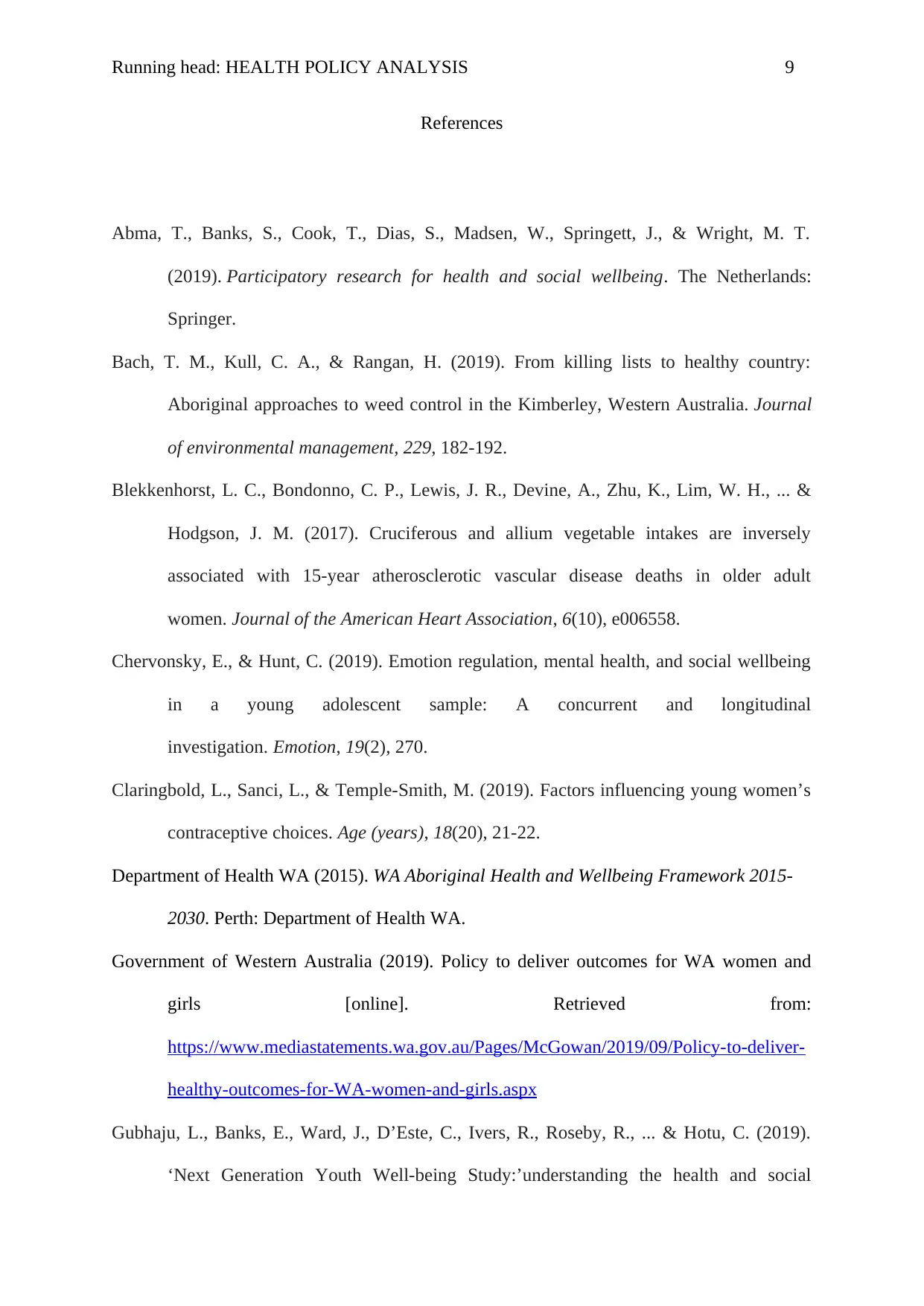
Running head: HEALTH POLICY ANALYSIS 9
References
Abma, T., Banks, S., Cook, T., Dias, S., Madsen, W., Springett, J., & Wright, M. T.
(2019). Participatory research for health and social wellbeing. The Netherlands:
Springer.
Bach, T. M., Kull, C. A., & Rangan, H. (2019). From killing lists to healthy country:
Aboriginal approaches to weed control in the Kimberley, Western Australia. Journal
of environmental management, 229, 182-192.
Blekkenhorst, L. C., Bondonno, C. P., Lewis, J. R., Devine, A., Zhu, K., Lim, W. H., ... &
Hodgson, J. M. (2017). Cruciferous and allium vegetable intakes are inversely
associated with 15‐year atherosclerotic vascular disease deaths in older adult
women. Journal of the American Heart Association, 6(10), e006558.
Chervonsky, E., & Hunt, C. (2019). Emotion regulation, mental health, and social wellbeing
in a young adolescent sample: A concurrent and longitudinal
investigation. Emotion, 19(2), 270.
Claringbold, L., Sanci, L., & Temple-Smith, M. (2019). Factors influencing young women’s
contraceptive choices. Age (years), 18(20), 21-22.
Department of Health WA (2015). WA Aboriginal Health and Wellbeing Framework 2015-
2030. Perth: Department of Health WA.
Government of Western Australia (2019). Policy to deliver outcomes for WA women and
girls [online]. Retrieved from:
https://www.mediastatements.wa.gov.au/Pages/McGowan/2019/09/Policy-to-deliver-
healthy-outcomes-for-WA-women-and-girls.aspx
Gubhaju, L., Banks, E., Ward, J., D’Este, C., Ivers, R., Roseby, R., ... & Hotu, C. (2019).
‘Next Generation Youth Well-being Study:’understanding the health and social
References
Abma, T., Banks, S., Cook, T., Dias, S., Madsen, W., Springett, J., & Wright, M. T.
(2019). Participatory research for health and social wellbeing. The Netherlands:
Springer.
Bach, T. M., Kull, C. A., & Rangan, H. (2019). From killing lists to healthy country:
Aboriginal approaches to weed control in the Kimberley, Western Australia. Journal
of environmental management, 229, 182-192.
Blekkenhorst, L. C., Bondonno, C. P., Lewis, J. R., Devine, A., Zhu, K., Lim, W. H., ... &
Hodgson, J. M. (2017). Cruciferous and allium vegetable intakes are inversely
associated with 15‐year atherosclerotic vascular disease deaths in older adult
women. Journal of the American Heart Association, 6(10), e006558.
Chervonsky, E., & Hunt, C. (2019). Emotion regulation, mental health, and social wellbeing
in a young adolescent sample: A concurrent and longitudinal
investigation. Emotion, 19(2), 270.
Claringbold, L., Sanci, L., & Temple-Smith, M. (2019). Factors influencing young women’s
contraceptive choices. Age (years), 18(20), 21-22.
Department of Health WA (2015). WA Aboriginal Health and Wellbeing Framework 2015-
2030. Perth: Department of Health WA.
Government of Western Australia (2019). Policy to deliver outcomes for WA women and
girls [online]. Retrieved from:
https://www.mediastatements.wa.gov.au/Pages/McGowan/2019/09/Policy-to-deliver-
healthy-outcomes-for-WA-women-and-girls.aspx
Gubhaju, L., Banks, E., Ward, J., D’Este, C., Ivers, R., Roseby, R., ... & Hotu, C. (2019).
‘Next Generation Youth Well-being Study:’understanding the health and social
⊘ This is a preview!⊘
Do you want full access?
Subscribe today to unlock all pages.

Trusted by 1+ million students worldwide
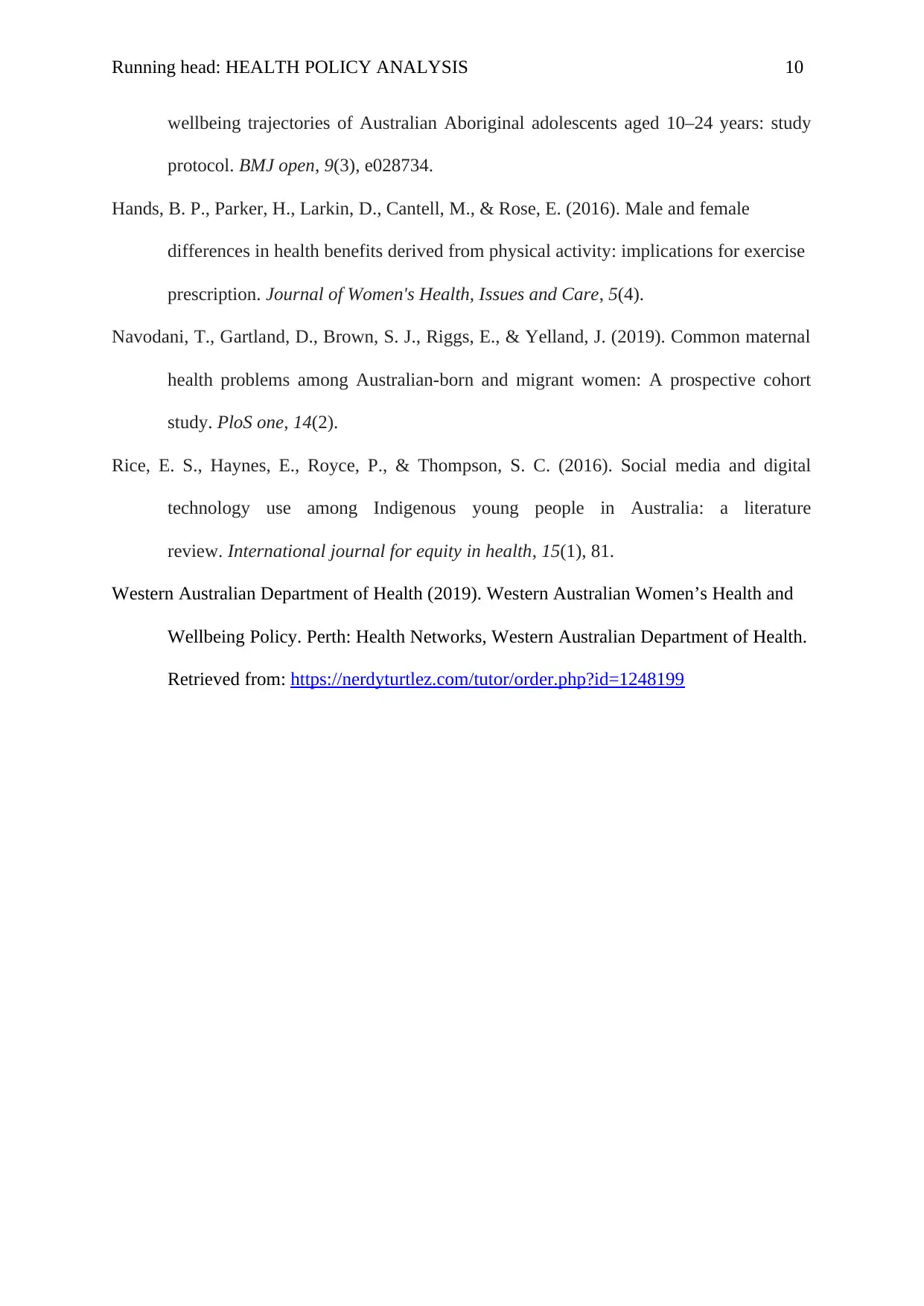
Running head: HEALTH POLICY ANALYSIS 10
wellbeing trajectories of Australian Aboriginal adolescents aged 10–24 years: study
protocol. BMJ open, 9(3), e028734.
Hands, B. P., Parker, H., Larkin, D., Cantell, M., & Rose, E. (2016). Male and female
differences in health benefits derived from physical activity: implications for exercise
prescription. Journal of Women's Health, Issues and Care, 5(4).
Navodani, T., Gartland, D., Brown, S. J., Riggs, E., & Yelland, J. (2019). Common maternal
health problems among Australian-born and migrant women: A prospective cohort
study. PloS one, 14(2).
Rice, E. S., Haynes, E., Royce, P., & Thompson, S. C. (2016). Social media and digital
technology use among Indigenous young people in Australia: a literature
review. International journal for equity in health, 15(1), 81.
Western Australian Department of Health (2019). Western Australian Women’s Health and
Wellbeing Policy. Perth: Health Networks, Western Australian Department of Health.
Retrieved from: https://nerdyturtlez.com/tutor/order.php?id=1248199
wellbeing trajectories of Australian Aboriginal adolescents aged 10–24 years: study
protocol. BMJ open, 9(3), e028734.
Hands, B. P., Parker, H., Larkin, D., Cantell, M., & Rose, E. (2016). Male and female
differences in health benefits derived from physical activity: implications for exercise
prescription. Journal of Women's Health, Issues and Care, 5(4).
Navodani, T., Gartland, D., Brown, S. J., Riggs, E., & Yelland, J. (2019). Common maternal
health problems among Australian-born and migrant women: A prospective cohort
study. PloS one, 14(2).
Rice, E. S., Haynes, E., Royce, P., & Thompson, S. C. (2016). Social media and digital
technology use among Indigenous young people in Australia: a literature
review. International journal for equity in health, 15(1), 81.
Western Australian Department of Health (2019). Western Australian Women’s Health and
Wellbeing Policy. Perth: Health Networks, Western Australian Department of Health.
Retrieved from: https://nerdyturtlez.com/tutor/order.php?id=1248199
1 out of 10
Related Documents
Your All-in-One AI-Powered Toolkit for Academic Success.
+13062052269
info@desklib.com
Available 24*7 on WhatsApp / Email
![[object Object]](/_next/static/media/star-bottom.7253800d.svg)
Unlock your academic potential
Copyright © 2020–2025 A2Z Services. All Rights Reserved. Developed and managed by ZUCOL.





